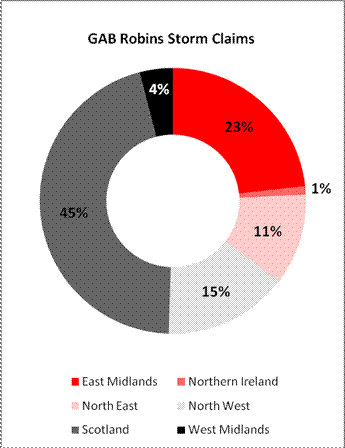But things could have been much worse had flood defences not been effective
The flood waters that battered parts of the UK are starting to recede, but the insurance industry is still assessing the damage caused.
The Environment Agency (EA) has said the situation is an improving one, and the number of severe flood warnings in place has now fallen to 12, down from 40 this morning.
The EA said it estimated around 1,400 properties flooded in the past 24 hours but at least 800,000 properties had been saved from damage by flood defences.
However, while the pressure may be easing, loss-adjusters and insurers across the country are still working to assess the damage and process claims coming in for storm damage and flooding.
GAB Robins has said Boston, Hull and East Yorkshire are the areas that have been hit hardest by the storm, while 45% of claims coming in to the loss-adjuster have originated in Scotland (see below).

And Birmingham-based LAS claims has said the recent weather has caused claims notifications to surge by 400%, and expects the situation to persist for the next two or three days.
LAS external operations director Max Dunworth said the LAS teams were very busy but coping well with the surge.
“Hotspots are the central belt of Scotland, and parts of Yorkshire and Nottinghamshire for storm damage, and the Humber estuary, Trent Valley, Norfolk coastal villages and Boston (Lincs) for flooding,” he said. “We’re fortunate that there is no single town or city that has been badly affected. We have been able to find all our customers alternative accommodation quickly and our teams are already on site assessing the damage.”
And some insurance companies have been called in to assist the emergency services by providing specialist teams to help those affected by the flooding.
The AA’s emergency weather team was asked to stand by for the Fire and Rescue Services in Hull to provide its specialist water rescue team to assist with victims caught in floods.
Swiftcover is also offering increased levels of cover to home insurance policyholders affected by the floods.
In an email sent to customers, seen by Insurance Times, Swiftcover said it is providing “£100 towards expenses for any household which is evacuated by the emergency services or authorities” in addition to its usual cover levels.
Flood defences are working
Despite the problems the storm has caused, AA head of special operations Darron Burness said the situation had been managed extremely well.
“While there remained concern that high tides late this afternoon may cause further flooding along the East Coast and the Thames Estuary, the threat of the tidal surge, in some locations the highest for 60 years, has been managed extremely well by the Environment Agency and emergency services,” he said.
“Unlike 1953, when there was extensive flooding along the east coast, householders and motorists have been kept well informed and most have heeded warnings to evacuate their homes when necessary and move their vehicles away from danger.”
And Burness added that the situation could have been much worse had adequate flood defences not already been in place.
“Flood defences built over recent years have also more than paid for the investment put in to them, too,” Burness said. “The events of the past 48 hours have shown how effective flood defence investment is.
“I hope that this will continue to be the focus of government investment. It’s hard to imagine a better form of return: new flood defences have, without doubt, saved billions of pounds in terms of avoided damage to property, infrastructure and the economy.”
Hosted by comedian and actor Tom Allen, 34 Gold, 23 Silver and 22 Bronze awards were handed out across an amazing 34 categories recognising brilliance and innovation right across the breadth of UK general insurance.







































No comments yet